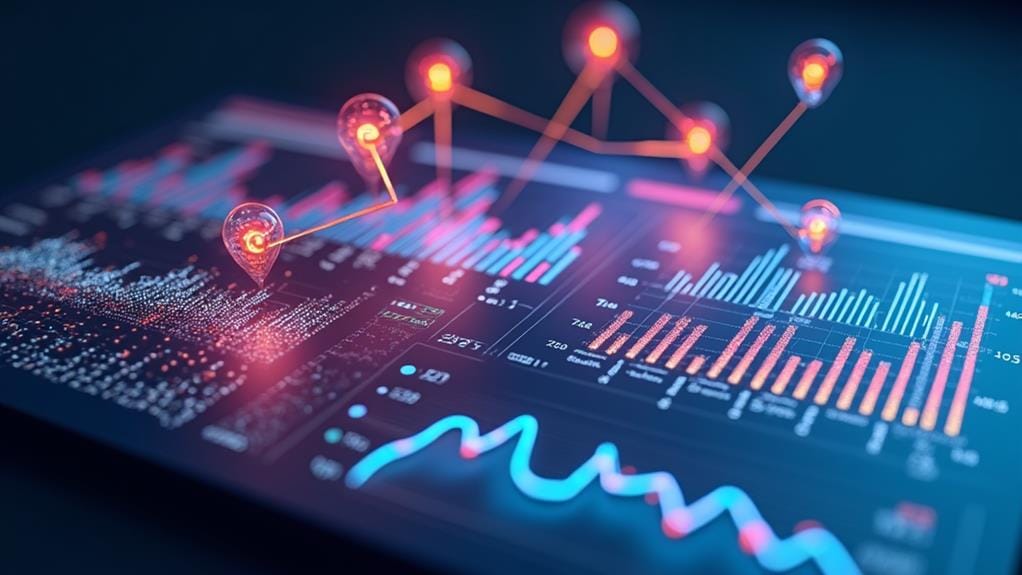

You'll transform your social media strategy from guesswork to data-driven success by harnessing análisis predictivo. Start by collecting extensive data through tools like Google Analytics[1] y Facebook[2] Insights to understand user behavior patterns. Machine learning algorithms can then identify hidden connections and forecast future trends, helping you create content that resonates with your audience before they even know they want it. Through Pruebas A/B y real-time monitoring, you can boost engagement rates by up to 30% while staying ahead of industry trends. Your data-driven approach to social media will reveal powerful insights that'll revolutionize your content strategy.

In today's digital landscape, análisis predictivo has become a cornerstone of successful marketing en redes sociales. You'll find that this powerful approach combines statistical analysis with algoritmos de aprendizaje automático to transform your social media data into ideas prácticas.
By analyzing historical user behavior y engagement patterns, you're able to forecast future trends and adapt your estrategia de contenidos accordingly. The insights into clicks provided by analytics can identify areas for improvement and highlight what drives engagement.
Think of predictive analytics as your crystal ball for social media success. You'll start with data collection from various platforms, gathering everything from likes and shares to click-through rates.
Then, sophisticated machine learning algorithms get to work, identifying patterns you might've missed and revealing hidden connections in user interactions. These algorithms, including decision trees and neural networks, help you understand what makes your audience tick.
The beauty of this approach lies in its ability to anticipate preferencias del público before they become obvious. You're not just reacting to trends anymore – you're staying ahead of them.
Éxito en análisis predictivo hinges on robust recogida de datos and systematic analysis methods. You'll need to leverage powerful herramientas de análisis como Google[3] Analytics, Facebook Insights, and Twitter Analytics to gather meaningful data about your social media engagement. These tools provide the foundation for understanding your audience behavior and making accurate predictions.
It's vital to choose tools that enable ideas prácticas to improve decision-making and optimize your social media strategies. Your data preparation process is imperative – don't skip this step! You'll want to clean and organize your data by removing duplicates and handling missing values. This guarantees your predictive models are working with reliable information.
Combine your quantitative metrics with qualitative insights from surveys and focus groups to get a complete picture of what makes your audience tick. Ready to dig deeper? That's where exploratory data analysis comes in. You'll use visualization tools to spot trends and patterns that mightn't be obvious at first glance.
Remember to regularly evaluate your data collection methods to stay on track with your goals. As social media evolves, you'll need to adapt your approach to maintain accurate predictions. Think of it as fine-tuning your crystal ball – the better your data, the clearer your view of future trends.

Creating powerful forecasting models requires a strategic blend of the right algoritmos and meticulous data preparation. When you're building effective forecasting models, you'll need to focus on selecting the perfect algorithms that can detect patterns in your historical datos de las redes sociales.
Social media strategies can produce a huge ROI social with minimal investment, making análisis predictivo a valuable tool. Your success hinges on thorough data preparation – cleaning, transforming, and standardizing your datasets to guarantee they're ready for analysis.
Here's what you'll want to prioritize in your predictive analytics journey:
Modern content strategy optimization leverages análisis predictivo to transform raw data into ideas prácticas for your social media campaigns. By analyzing historical engagement metrics and user behavior patterns, you'll gain a clear understanding of what content resonates with your audience and when they're most likely to engage with it.
Incorporación de participación en tiempo real strategies, such as responding promptly to cliente[4] messages, further enhances customer relationships and strengthens brand loyalty.
You'll want to embrace segmentación de la audiencia as your secret weapon for creating personalized content that speaks directly to different user groups. When you combine this with Pruebas A/B, you're looking at potential engagement increases of up to 30%.
Social media analytics tools will help you pinpoint those golden posting times when your audience is most active, boosting your content's visibility by as much as 50%.
Don't forget to keep an eye on trending topics through predictive analytics – they're your crystal ball for content calendars. By staying ahead of emerging trends, you'll position yourself as an industry leader rather than a follower.

Building on your optimized content strategy, effective performance tracking serves as the backbone of continuous improvement in social media marketing.
By leveraging predictive analytics and real-time analytics tools, you'll gain invaluable insights into your audience behavior and user interactions. Your success hinges on consistently monitoring key metrics and making data-driven adjustments to your content strategies.
To supercharge your performance tracking efforts, focus on these essential elements:
You'll work with four analytics types: descriptive analytics shows what happened, diagnostic analytics explains why, predictive analytics forecasts what's next, and prescriptive analytics tells you actions to take for desired outcomes.
You'll find predictive analytics in content optimization for Netflix recommendations, Facebook's audience segmentation for ads, trend identification in retail forecasting, and behavior modeling that helps companies predict customer churn and engagement patterns.
You'll analyze social media through engagement metrics, audience insights, trend identification, content performance, sentiment analysis, platform comparison, influencer impact, timing optimization, campaign effectiveness, and data visualization to make informed marketing decisions.
Like ancient oracles, you'll use forecasting and predictive analytics to glimpse the future through data mining, machine learning, and time series analysis, helping you make informed decisions based on consumer behavior patterns.